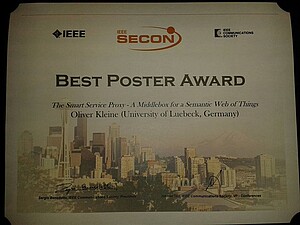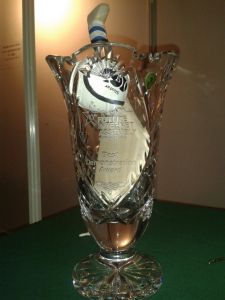Dr.-Ing. Oliver Kleine

University of Lübeck
Institute of Telematics
Ratzeburger Allee 160
23562 Lübeck
| Email: | kleine(at)itm.uni-luebeck.de |
| Phone: | |
| Fax: | +49 451 3101 6404 |
After graduating from the University of Luebeck with a M.Sc. in computer science, I joined the ITM as a research associate in July 2010. Since then my focus is on the smooth integration of the Internet resp. Web of Things with the common Internet resp World-Wide Web. Besides the network integration my research interest particularly includes data distribution and recovery in the IoT as well as data security.
Short CV
- Since April 2011:
Associate lecturer at the University of Applied Science in Luebeck - Since July 2010:
Research associate at the Institute of Telematics at the University of Luebeck - October 2007 - July 2010:
Master student of Informatics at the University of Luebeck (graduated with M.Sc. in July 2010) - October 2005 - October 2007:
IT Project Manager at Telefónica Deutschland GmbH - October 2002 - December 2005:
Diploma student of business informatics at the FHDW Paderborn, University of Applied Science (graduated with Dipl.-Wirt.-Inf (FH) in December 2005) - May 2001 - October 2005:
Projectmanagement assistant at Telefónica Deutschland GmbH
News

SECON and SWANSITY 2015 (Seattle, USA)
In June 2015 I presented a poster about the Smart Service Proxy (SSP) at the conference "SECON 2015" in Seattle. As stated in the posters title the proxy is a "A Middlebox to realize a Semantic Web of Things". The poster was awarded the "best poster" at SECON 2015 and can be downloaded here.
In a workshop (SWANSITY) which was co-located with the SECON, I also presented a case study that utilizes both, the simulation framework VASILI (implemented by Sebastian Ebers) and the SSP. For the case study we monitored urban traffic using Semantic Web Services on approx. 2500 (simulated) smartphones each of which is attached to one out of 2500 (simulated) vehicles.
iThings 2014 (Taipei, Taiwan)
In September 2014 I attended the iThings 2014 conference to present my IETF draft (proposed RFC) for CoAP Endpoint Identification. The poster that sums up both, the problem and the proposed solution can be downloaded here.

FIA 2013 (Dublin, Ireland)
In May 2013 I was in Dublin with some other partners of SPITFIRE to participate at the demo competition of the Future Internet Assembly. We demonstrated our approach to integrate the Internet of Things with the common Internet on network layer and with the Semantic Web on application layer. We presented a smart office buliding with rules to react on certain conditions (e.g. switch the AC on, when somebody enters the office and the outside temperature is more than 21°C). Such rules can easily be constructed by combining arbitrary different data sources from the Semantic Web (resp. linked data cloud), so home automation is just one item on a virtually endless list of thinkable usecases.
The visitors were asked to vote for the best demo via SMS. The SPITFIRE demo won the competition! The picture shows the trophy with some equipment for hurling, which is a very famous sport in Ireland.
Open Source Software Development
- Smart Service Proxy:
- Sources available at https://github.com/ict-spitfire/smart-service-proxy
- Enables IoT devices to be accessed using well-known Internet protocols (like HTTP, TCP, IPv6) without any need to implement those protocols for IoT devices.
- Provides serialization format independet caching of semantic web resource descriptions (for a number of standard serialization formats like N3 or RDF/XML)
- Enables the creation of semantic entities by using SPARQL and access to their status using the above mentioned technologies. Semantic entities as an outcome of the Spitfire-Project represent (even non-technolgical) everyday items like tables or rooms as webservices. Semantic entities mostly base on aggrgated sensor data but hide the complexity of programming resource constraint devices (like wireless sensor nodes) from the user.
- JAVA implementation of CoAP (Constrained Application Protocoll)
- Enables RESTful webservices for resource constrained devices
- Sources available at https://github.com/okleine/nCoAP
- Accoording to RFCs 7252 and 7641

- Über uns
- Vision / Mission
- Mitarbeitende
- Stefan Fischer
- Andreas Schrader
- Horst Hellbrück
- Ines Schiebahn
- Dirk Frank Schmidt
- Edgar Baake
- Malin Böttcher
- Lea Christine Brandl
- Susan Brauer
- Moussa Doumbiya
- Bennet Gerlach
- Mohamed Hail
- Christian Hyttrek
- Max Kaussow
- Börge Kordts
- Florian-Lennert Lau
- Yasser Mawad
- Patrick Pfau
- Ian Pösse-Koch
- Sarah Scheer
- Ingrid Schumacher
- Nazli Siasi
- Klaus-Dieter Schumacher
- Marc Stelzner
- Finn Stoldt
- Nils Stumpf
- Nailya Uzhakova (birth name Sabirzyanova)
- Regine Wendt (birth name Geyer)
- Kontakt
